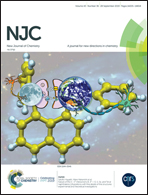Ligase chain reaction-based electrochemical biosensor for the ultrasensitive and specific detection of single nucleotide polymorphisms†
Abstract
In this study, a simple, robust, label-free electrochemical biosensor based on the ligase chain reaction (LCR) was developed for the highly sensitive and selective detection of single nucleotide polymorphisms (SNPs) using Fe(CN)63−/Fe(CN)64− as a redox indicator. High sensitivity and specificity were achieved by using the LCR, which employs a thermostable and single-base discerning Hifi Taq DNA ligase to repeatedly ligate adjacently hybridized LCR-specific probes during thermal cycles, resulting in the highly specific exponential amplification of DNA targets. The electrochemical signal of the biosensor was further decreased using stem-loop probe DNA (SL-DNA), which specifically hybridized with LCR products on the electrodes. The linear dynamic range and high sensitivity of the mutant DNA (MutDNA) and wild-type DNA (WtDNA) LCR-based electrochemical biosensors for the detection of MutDNA and WtDNA were studied in vitro, with a broad linear dynamic range of 10 aM to 10 pM and detection limits of 1.18 aM and 0.35 aM, respectively. In addition, the MutDNA and WtDNA LCR-based electrochemical biosensors were able to accurately detect allele frequency changes as low as 0.1%. In summary, the developed LCR-based electrochemical biosensor provides a useful platform to monitor SNPs in a highly sensitive and specific manner.



 Please wait while we load your content...
Please wait while we load your content...